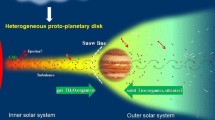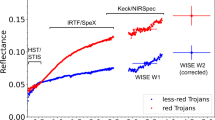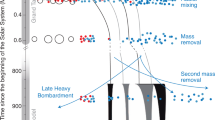Abstract.
The Near-Earth Object (NEO) population, being the remnants of the building blocks that originally formed our solar system, allows us to understand the initial conditions that were present in the protosolar nebula. Its investigation can provide crucial information on the origin and early evolution of the solar system, and shed light on the delivery of water and organic-rich material to the early Earth. Furthermore, the possible impact of NEOs poses a serious hazard to our planet. There is an urgent need to undertake a comprehensive physical characterization of the NEO population, particularly for the ones with the higher likelihood of catastrophic impact with the Earth. One of the main aims of the NEOShield-2 project (2015-2017), financed by the European Commission in the framework of the HORIZON 2020 program, is to undertake an extensive observational campaign and provide a physical and compositional characterization for a large number of NEOs in the < 300 m size range, retrieving in particular their mitigation-relevant properties (size, shape, albedo, diameter, composition, internal structure, ...) in order to design impact mitigation missions and assess the consequences of an impact on Earth. We carried out visible photometric measurements for a sample of 158 uncharacterized NEOs. We also made use of visible and near-infrared spectroscopy to assess NEO composition and perform a mineralogical analysis. We found that carbonaceous C-complex asteroids deserve a special attention, since their physical structure (e.g., primitive nature, porosity) and their orbital parameters (mainly the inclination) make at the moment challenging the design of a successful mitigation strategy. Indeed, the most advanced mitigation technique (the kinetic impactor) is less effective on these bodies, and the high inclination of some possible impactors require a launch vehicle capability beyond the one currently available.
Similar content being viewed by others
References
A. Izidoro, K. de Souza Torres, O.C. Winter, N. Haghighipour, Astrophys. J. 767, 54 (2013)
S.M. Rehan, R. Leys, M.P. Schwarz, PLoS One 8, e76683 (2013)
D. Perna, M.A. Barucci, L. Drube, Planet. Space Sci. 118, 311 (2015)
R.P. Binzel, V. Reddy, T.L. Dunn, Asteroids IV (University of Arizona Press, Tucson, 2016) pp. 243--256
M. Delbo, G. Libourel, J. Wilkerson et al., Nature 508, 233 (2014)
D. Perna, M.A. Barucci, M. Fulchignoni, Astron. Astrophys. 21, 65 (2013)
D. Perna, M.A. Barucci, S. Fornasier et al., Astron. Astrophys. 510, 53 (2010)
M. Popescu, M. Birlan, D.A. Nedelcu, Astron. Astrophys. 544, 130 (2012)
F.E. DeMeo, R.P. Binzel, S.M. Slivan, S.J. Bus, Icarus 202, 160 (2009)
K.A. Holsapple, Mitigation of hazardous comets and asteroids (University Press, Cambridge, UK, 2004) p. 113
S. Ieva, E. Dotto, E. Mazzotta Epifani, in preparation (2017)
S. Ieva, E. Dotto, D. Perna et al., Astron. Astrophys. 569, 59 (2014)
D. Perna, E. Dotto, S. Ieva et al., Astron. J. 151, 11 (2016)
T.L. Dunn, T.J. McCoy, J.M. Sunshine, H.Y. McSween, Icarus 208, 789 (2010)
C.A. Angeli, D. Lazzaro, Astron. Astrophys. 391, 757 (2002)
M. Lazzarin, S., Marchi, S. Magrin, J. Licandro, Mon. Not. R. Acad. Sci. 359, 1575 (2005)
S.K. Fieber-Beyer, M.J. Gaffey, P.S. Hardersen, V. Reddy, Icarus 221, 593 (2012)
Author information
Authors and Affiliations
Corresponding author
Rights and permissions
About this article
Cite this article
Ieva, S., Dotto, E., Mazzotta Epifani, E. et al. Physical characterization of the near-Earth object population. Eur. Phys. J. Plus 132, 356 (2017). https://doi.org/10.1140/epjp/i2017-11622-6
Received:
Accepted:
Published:
DOI: https://doi.org/10.1140/epjp/i2017-11622-6




